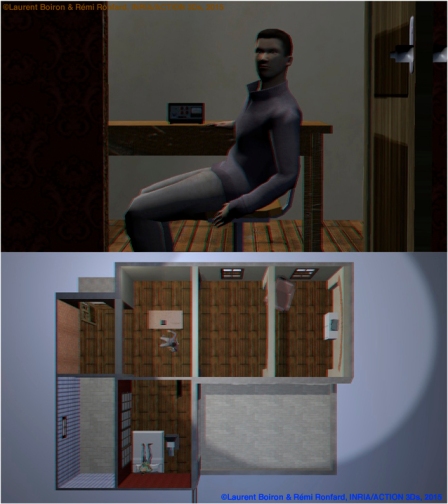Thanks to my PhD supervisor Giusy PISANO who teaches at the French National Film School Louis Lumière (La Plaine Saint-Denis, France), I got involved in the “Action 3Ds” research project.
CONTEXT
What is Action 3Ds research program?
Action 3Ds is a four years research program that aims to develop the Dynamic Stereoscopic Previz (DSP), a new pre-visualisation software designed for S3D films.
Who is involved?
Stereographers from Binocle 3D helped Rémi RONFARD and Laurent BOIRON, engineers from the French Institute for Computer Science and Automation (Institut National pour la Recherche en Informatique et en Automatique – INRIA), to design the software. Louis Lumière Film School provided the facilities to make a film for testing the software.
What is the film?
Jonathan BOCQUET, who graduated from Louis Lumière Film School in 2011 (his diploma thesis research focused on how stereoscopic cinema influences the filming), wrote a short horror film untitled Endless Night:
“James is hiding in an abandoned house with his girlfriend Mary, who is eight months pregnant. One night, James catches a message from his radio: the refugee camp they are trying to reach, has been attacked by zombies. James decides to go out while Mary is sleeping, to figure out what happened. A couple of hours later, a noise wakes Mary up… ”
What are the tests?
Working on Jonathan’s screenplay and shot list, INRIA engineers designed the previz of the shots, using the Dynamic Stereoscopic Previz. Then, a professional crew made the film.
We were free to film shots differently from the previz, as long as we also filmed the shots according to the previz, so as to validate the settings (such as focal length, distance and height, and S3D settings) implemented in the Dynamic Stereoscopic Previz.
Tests were also planned after the filming, so as to compare the stereography between the pre-visualised shots and the shots that were actually filmed.
MY JOB IN “ACTION 3Ds”
I worked as script supervisor on Jonathan’s film Endless Night.
Although I was hired about a month before the filming (earlier than for the shootings at Clermont-Ferrand), it was still late comparing to the production planning. Indeed, a first shooting had been made about a year ago, in 2014. Apparently, it has not been satisfying enough, so people decided that another shooting had to be made.
Jonathan did a shot list and a storyboard he sent to Rémi Ronfard and Laurent Boiron.
Pre-visualising the shot list
A two-days meeting happened three weeks before the shooting. I was working on a (2D) short film at that time, so I could only attend the meeting on the second day.
INRIA engineers had made a previz working on Jonathan’s storyboard. Many thanks to Rémi Ronfard and Laurent Boiron who allowed me to share the image below from the DSP:
We discussed the shot list, proposing to film some of the shots differently. Laurent was applying our ideas in real-time on the DSP, according to our discussion. This previz has been a valuable tool for me. It helped me to visualise the set, which I had never seen. I was able to make propositions according to the space we were about to film. For example, moving a little the camera position so as to give the shot some perspective back and emphasise the stereoscopy. Watching the shots and the floor plan on the previz also caught my attention on some of the main props that were moving too much instead of staying at the same place. Everybody knows that cinema is the art of cheating, but there are some limits to keep the space consistent, especially when filming in S3D.
Designing the stereography
Just before the filming began, we discussed with Jeanne Guillot, the stereographer, about the stereography. We first thought of applying a sort of “stereoscopic theme” to each character. The idea was to apply a special stereoscopic treatment to James, making him “stereographically” a zombie from the beginning of the film. The scenic box would progressively increase when filming Mary, so as to get the same stereoscopic treatment for both the characters at the end of the film. That idea seemed nice, but as we planned to use lots of different focal length (from 28mm to 80mm), we thought that it would not work properly.
That is the reason why we decided to keep a “normal” spatial treatment in the first scene. Then, once Mary has woken up in the middle of the night because of a strange noise, the stereoscopy would help to deepen and distort the space in order to underline the strangeness and Mary’s discomfort.
In my next post I will share my experience during the filming.
DOCUMENTS
Jonathan Bocquet, L’intégration du procédé relief dans le découpage cinématographique (in French), diploma thesis, Cinema Department, École Nationale Supérieure Louis Lumière, 2011. Available at: http://www.ens-louis-lumiere.fr/formation/recherche/memoires-de-fin-detudes/cinema/2011.html
Sergi Pujades, Laurent Boiron, Remi Ronfard, Frédéric Devernay. “Dynamic Stereoscopic Previz”. International Conference on 3D Imaging, Dec 2014, Liege, Belgium. Available at: https://hal.inria.fr/hal-01083848
Laurent Boiron, Rémi Ronfard. “Stereoscopic Previz in the Blender Game Engine”. Blender Conference, Oct 2014, Amsterdam, Netherlands. 2014. Available at: https://hal.inria.fr/hal-01086760

Leave a comment